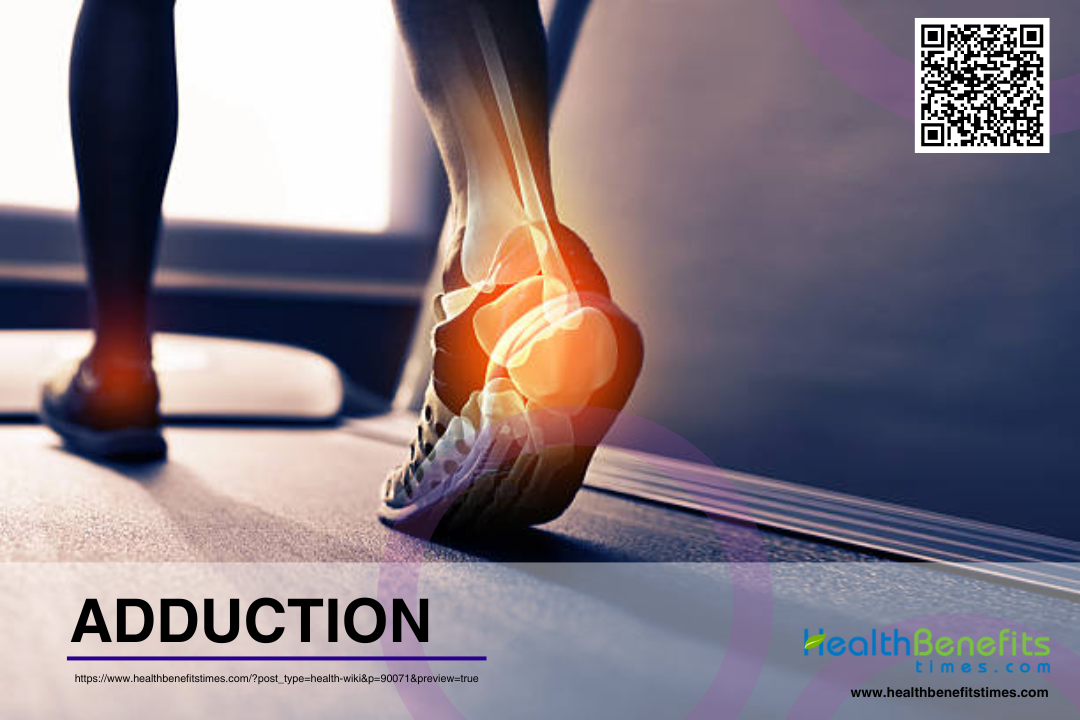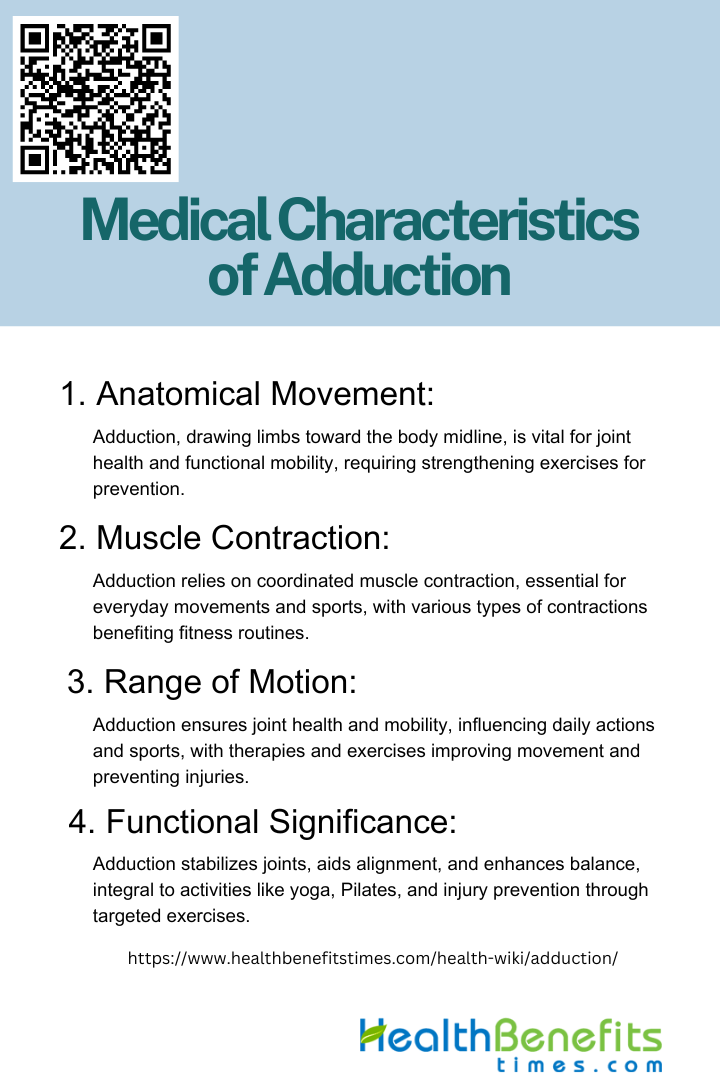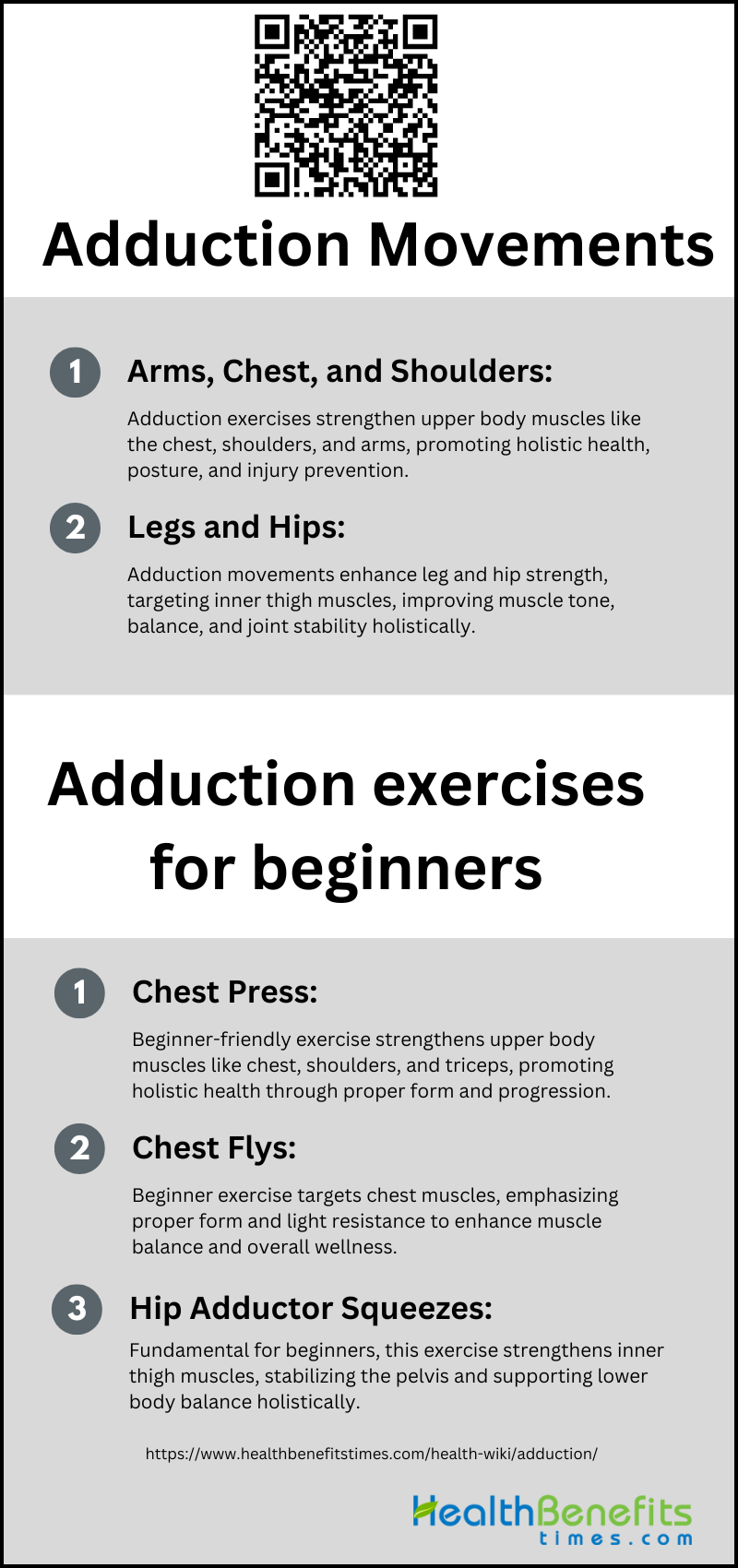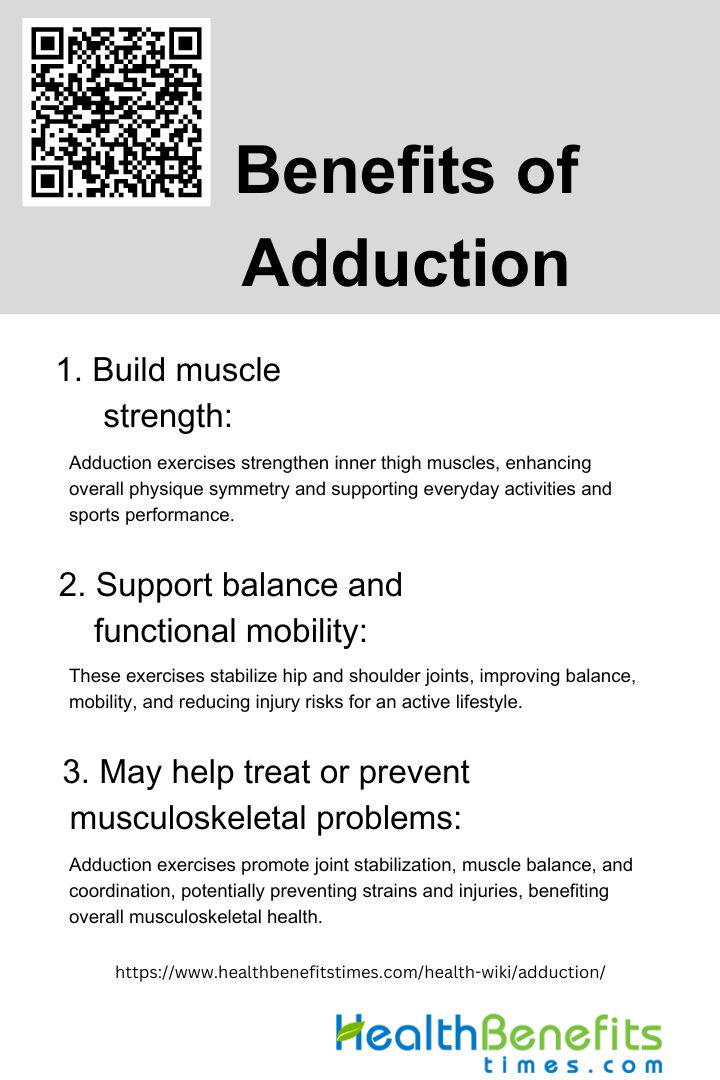 According to article, Adduction is a key movement that involves drawing a limb or body part toward the body’s midline, promoting stability and coordination. This motion is central to a well-functioning musculoskeletal system, ensuring proper joint alignment and muscle balance. Beyond its role in everyday activities and exercise, adduction supports posture, reduces the risk of injuries, and contributes to overall well-being. It’s also linked to critical biological functions, such as the formation of the cytoskeleton and cellular processes, and is implicated in health concerns like cancer development through DNA adducts. By integrating adduction exercises into fitness regimens, individuals can achieve a more aligned, strong, and harmonious physical state, which is vital for maintaining health and preventing ailments.
According to article, Adduction is a key movement that involves drawing a limb or body part toward the body’s midline, promoting stability and coordination. This motion is central to a well-functioning musculoskeletal system, ensuring proper joint alignment and muscle balance. Beyond its role in everyday activities and exercise, adduction supports posture, reduces the risk of injuries, and contributes to overall well-being. It’s also linked to critical biological functions, such as the formation of the cytoskeleton and cellular processes, and is implicated in health concerns like cancer development through DNA adducts. By integrating adduction exercises into fitness regimens, individuals can achieve a more aligned, strong, and harmonious physical state, which is vital for maintaining health and preventing ailments.
Functional Significance of Adduction
Adduction, the movement of drawing limbs toward the body’s centerline, is essential for stability and balance in both daily life and athletic activities. While hip adduction has not proven to be a decisive factor in improving patellofemoral pain syndrome outcomes, controlling knee movement is vital for knee joint stability and injury prevention. In vocal health, adduction arytenopexy enhances vocal fold function for better sound production. Additionally, adducin in red blood cells is crucial for their adaptability within the circulatory system. Strong hip adductors support a stable pelvis, foundational for good posture and back health, and adduction exercises promote muscular balance and a strong mind-body connection. Incorporating adductive movements into exercise routines fosters a balanced and resilient physique, contributing to overall well-being by improving posture, preventing injuries, and ensuring equal strength distribution across the body.
Medical Characteristics of Adduction
Adduction is a fundamental movement in the human body, involving the motion of a limb or other body part toward the central line of the body. This movement is crucial for various daily activities and exercises, playing a significant role in maintaining balance and coordination. Understanding the mechanics and implications of adduction can enhance one’s approach to physical health and fitness.
1. Anatomical Movement
According to article, The anatomical movement where limbs or body parts are drawn toward the body’s midline, is fundamental to our joint health and functional mobility. It’s a key player in everyday actions like lowering arms or crossing legs, relying on adductor muscles situated in areas like the inner thigh. In the realm of sports medicine, it’s been observed that weak hip adduction can lead to a higher chance of related injuries, underscoring the need for preventive exercises such as the Copenhagen Adduction. Regularly incorporating adduction-strengthening exercises into fitness routines not only bolsters these crucial muscles but also promotes a harmonious balance within our musculoskeletal system. This practice is vital for enhancing body alignment, boosting stability, and reducing injury risks, making it a pivotal aspect of holistic health and wellness programs.
2. Muscle Contraction
Muscle contraction during adduction is crucial for promoting overall health and wellness. Adduction, the action that brings a limb closer to the body’s center, relies on the coordinated effort of muscles such as the adductor magnus, longus, and brevis in the thigh, as well as the pectoralis major in the chest. These muscles work together through a series of nerve signals and muscle fiber interactions, which begin when the brain sends a command that triggers the release of neurotransmitters, leading to muscle fiber contraction. This process is essential not only for everyday movements like walking and crossing legs but also for sports that require side-to-side actions. Recognizing the different types of muscle contractions—concentric, eccentric, and isometric—is beneficial for enhancing fitness routines and preventing injuries. Concentric contractions cause muscles to shorten, eccentric contractions involve lengthening under tension, and isometric contractions maintain muscle length with tension. Training these contractions can improve joint stability and mobility, key components for an active lifestyle and injury avoidance.
3. Range of Motion
Adduction, the movement of limbs toward the body’s center, is vital for joint health and functional mobility. It’s involved in everyday actions like crossing your legs and sports that require side-to-side motion. A full range of motion in adduction helps maintain muscular balance and proper body mechanics. However, a restricted range could indicate muscle or joint issues, which holistic health professionals often address with specific exercises and therapies to improve movement and prevent injuries. The normal range for shoulder adduction, for example, is about 10 to 20 degrees, but this can differ due to age, gender, and activity level. Regular physical activity and exercises tailored to promote adduction can greatly improve joint function and overall health, in line with holistic wellness that seeks to harmonize body system functions.
4. Functional Significance
The movement of drawing a limb towards the body’s midline, is vital for joint stability and proper alignment, playing a key role in maintaining balance and coordination in daily activities and fitness routines. Integral to holistic health practices like yoga and Pilates, adduction contributes to the strength and flexibility of muscle groups, creating a balanced synergy. Regularly incorporating adduction exercises into workouts not only enhances athletic performance but also aids in injury prevention by strengthening muscles around pivotal joints such as the hips and shoulders. This ensures that the body can support a variety of movements and withstand different loads, promoting better posture and reducing the risk of muscle imbalances.
Adduction Movements
Adduction movements are a fundamental aspect of holistic health, playing a crucial role in maintaining joint stability and muscular balance. These movements, which involve drawing a limb toward the midline of the body, are essential in various physical activities and exercises. Below is a list of key adduction exercises that can enhance your fitness routine and contribute to overall wellness.
1. Arms, Chest, and Shoulders
Adduction movements are key to building a strong and balanced upper body, crucial for holistic health and fitness. By drawing the arms or legs towards the body’s center, these exercises engage vital muscles such as the pectoralis major in the chest, deltoids in the shoulders, and various arm muscles. Regularly incorporating movements like chest flys, cable crossovers, and close-grip bench presses into your fitness routine can lead to a more powerful upper body, improved posture, and a lower risk of injuries. Focusing on adduction not only enhances your physical appearance but also bolsters your body’s natural movements, contributing to a comprehensive approach to wellness and daily functional strength.
2. Legs and Hips
Adduction movements, where limbs are drawn towards the body’s center, are vital for leg and hip strength, enhancing fitness and wellness. These exercises target the inner thigh muscles—adductor longus, brevis, and magnus—key players in pelvic stability and proper alignment. Regularly including movements like side-lying leg lifts, cable machine adductions, and Pilates in a holistic health routine can improve muscle tone, coordination, and balance. Moreover, they bolster hip joint function and stability, which is beneficial for daily activities and sports, while also minimizing injury risks. By integrating these exercises, individuals can achieve a more balanced body and a robust approach to health and fitness.
Adduction exercises for beginners
Embarking on a fitness journey can be both exciting and overwhelming, especially when exploring specific muscle groups like the adductors. For beginners, understanding and effectively engaging these muscles is crucial for overall lower body strength and stability. Here are some beginner-friendly adduction exercises that can be easily incorporated into your holistic health and fitness routine.
1. Chest press
The chest press is a key exercise for beginners aiming to bolster upper body strength and promote holistic health. This foundational movement works the pectorals, shoulders, and triceps and can be performed with various equipment like dumbbells, barbells, or specialized machines, catering to different fitness levels and environments. For those starting out, it’s important to use light weights and focus on proper form—lying on a bench with feet flat on the ground and pressing the weights up in a controlled manner, directly over the chest. Slowly returning to the starting position and maintaining a mind-muscle connection are vital for maximizing benefits and preventing injury. Regularly including the chest press in a workout routine not only builds muscle but also enhances overall wellness by improving posture, supporting daily functions, and even aiding those with cardiovascular conditions. The press-up device, with its straightforward design, is particularly user-friendly, making strength training accessible and safe for a wide audience, including the middle-aged, elderly, and those carrying extra weight.
2. Chest flys
Chest flys are a key exercise for beginners aiming to strengthen their chest and upper body. This movement, which simulates the flapping of a bird’s wings, targets the pectoral muscles by extending the arms to the sides with weights and bringing them together above the chest. It’s crucial to prioritize proper form over heavy weights to prevent injury and ensure effective muscle engagement. Starting with light resistance, individuals can safely progress, increasing the weight as they become more adept. Chest flys, adaptable with dumbbells, cables, or machines, are a valuable addition to any holistic health fitness routine, enhancing muscle balance, posture, and functional strength for everyday activities. By integrating this exercise into their regimen, beginners can work towards a well-rounded physique and improved overall wellness.
3. Hip adductor squeezes
Hip adductor squeezes are a fundamental exercise for beginners aiming to fortify their inner thigh muscles, which play a pivotal role in stabilizing the pelvis and supporting lower body balance. These squeezes, essential for reducing the risk of groin injuries in sports such as football and soccer, can be done anywhere with no special equipment—just a small, soft ball or a folded towel. To perform this exercise, either sit upright on a chair with feet planted on the ground or lie on your back with knees bent; place the ball or towel between your knees and press inward, maintaining the squeeze for a few seconds before releasing. For optimal results, focus on controlled movements and repeat the process for several sets. This straightforward yet effective routine not only builds muscle endurance and joint health but also contributes to a comprehensive wellness program by enhancing muscle tone and preventing injuries.
Common Exercises Involving Adduction (DND)
The mechanics of our body’s movements is crucial for achieving overall wellness. Among these, exercises involving adduction play a pivotal role in strengthening and stabilizing key muscle groups. Here, we delve into common exercises that incorporate adduction, enhancing both physical health and functional mobility.
1. Hip adductor
The hip adductors are key to a strong and stable lower body, essential for pelvis stabilization and enhancing mobility. Exercises such as sumo squats, Copenhagen adduction, lateral lunges, and the use of machines target these inner thigh muscles, improving stability, balance, and posture. Pilates and yoga further support this by offering poses like “tree” and “goddess” that promote muscle tone, mindfulness, and body awareness. Research underscores the effectiveness of these exercises in injury prevention and treatment, with studies noting their benefits in pain reduction and increased eccentric strength, particularly in athletes. Regularly incorporating hip adductor workouts into a fitness regimen is not only crucial for injury prevention but also for achieving a balanced approach to holistic health and wellness, ensuring every muscle group is nurtured for optimal physical harmony.
2. Lateral lunge
The lateral lunge is a dynamic and versatile exercise that plays a crucial role in holistic health fitness by targeting the adductor muscle group, key for pelvis stability and lower body strength. This exercise not only works on the inner thigh muscles but also involves the quadriceps, hamstrings, and glutes, enhancing flexibility, balance, and functional strength. To execute a lateral lunge, stand with feet shoulder-width apart, step widely to one side, and bend the knee while keeping the opposite leg straight, ensuring the back remains straight to prevent injury. This lateral movement challenges the body’s frontal plane, offering a unique test to mobility and balance, making it a valuable exercise for anyone aiming to boost athletic performance, address muscle imbalances, or diversify their fitness routine. By simultaneously engaging both adductors and abductors, the lateral lunge supports natural movement patterns and is a fundamental addition to a comprehensive wellness regimen, promoting stability and mobility throughout the lower body.
3. Cossack squat
The Cossack squat, a dynamic and multifaceted exercise, is an excellent addition to any holistic health and fitness routine, targeting key lower body muscles such as the quadriceps, hamstrings, glutes, and adductors. Its lateral movement pattern not only builds strength and endurance but also promotes flexibility, mobility, and joint health, particularly in the hips, knees, and ankles. By shifting weight from side to side while maintaining a deep squat, it encourages better balance, functional movement, and neuromuscular coordination. Regularly performing this exercise can lead to improved athletic performance, reduced injury risk, and enhanced overall lower body power, making it a cornerstone for a balanced approach to fitness and wellness.
4. Lat pull-down
The lat pull-down is a fundamental exercise for strengthening the upper body, particularly the latissimus dorsi muscles, which are key for a strong, V-shaped back. This compound movement not only sculpts the back but also engages secondary muscles like the biceps, shoulders, and core, making it a comprehensive workout for improving wellness and physical health. Executed on a cable machine, the lat pull-down supports daily functional movements and is adaptable for all fitness levels, with adjustable resistance to ensure proper form and safety. Integrating this exercise into a holistic fitness routine can lead to better posture, enhanced back strength, and a well-rounded upper body development, contributing to overall health and fitness.
5. Pull-up
Pull-ups are a fundamental exercise for holistic health and fitness, targeting the upper body and engaging a range of muscles such as the latissimus dorsi, biceps, and trapezius. This compound movement is key for developing muscle balance and functional strength, as it involves drawing the arms towards the midline of the body, a motion known as adduction. Suitable for various fitness levels, pull-ups can be adapted with assistance, like resistance bands for beginners, or added weight for advanced individuals. The exercise’s adaptability extends to grip variations—pronated, supinated, and neutral—which can fine-tune muscle engagement to meet personal health goals. Regularly including pull-ups in a workout routine not only sculpts the physique but also bolsters joint stability and daily functional capabilities, making it an invaluable component of a well-rounded wellness program.
6. Chest fly
The chest fly is an essential exercise for bolstering upper body strength, particularly the pectoral muscles, and is a key component of holistic health and fitness programs. This exercise involves a sweeping motion where the arms move from an extended position to meeting in front of the chest, effectively working the chest muscles and adductor muscles. Whether performed with dumbbells, cables, or machines, the chest fly promotes muscular adduction, enhances posture, and supports joint health without overburdening the shoulders. By including variations like the dumbbell, incline, and cable fly, one can target various parts of the chest, aiding in muscle development and definition. Incorporating the chest fly into a well-rounded workout routine contributes to a balanced mix of strength, flexibility, and overall well-being, in line with a holistic approach that values the interconnectedness of the body’s systems.
Benefits of Adduction
Adduction exercises are a crucial component of a balanced fitness regimen, particularly for those aiming to enhance overall muscular balance and joint stability. These movements, which involve pulling limbs toward the body’s midline, not only strengthen the inner thigh muscles but also play a significant role in improving posture and reducing the risk of injuries. Here are some key benefits of incorporating adduction exercises into your workout routine:
1. Build muscle strength
Adduction exercises, which involve drawing a limb toward the body’s midline, are key to creating a balanced and strong physique, especially in areas like the inner thighs that are often overlooked. These movements engage not just the inner thigh muscles but also hip flexors and other stabilizers, contributing to a symmetrical build. They are crucial for everyday activities as well as sports, aiding in joint health and injury prevention. By incorporating these exercises into your fitness routine, you target the adductor muscles that play a vital role in stabilizing the pelvis and facilitating a variety of movements. This not only boosts athletic performance but also ensures proper body alignment and balance, reducing injury risks. For a holistic health and fitness approach, adduction workouts are indispensable, enhancing physical strength and fostering a resilient, well-rounded body.
2. Support balance and functional mobility
Adduction exercises are key to promoting balance and functional mobility, which are vital for an active and healthy lifestyle. These exercises involve moving limbs toward the center of the body, which stabilizes the hip and shoulder joints and strengthens the inner thigh muscles. This not only helps in performing everyday activities with ease and precision but also prevents injuries by ensuring a stable pelvis and reducing muscle imbalances. Regularly including adduction movements in your fitness regimen can improve your ability to walk, run, and engage in sports, leading to a well-toned lower body and better joint health. Embracing these exercises is a smart move for anyone looking to enhance their physical capabilities and enjoy a life free from mobility-related injuries.
3. May help treat or prevent musculoskeletal problems
Adduction exercises, which bring limbs toward the body’s center, are a vital aspect of a holistic health and fitness routine, promoting musculoskeletal health and potentially preventing related issues. These movements are key for joint stabilization and muscle strengthening, ensuring proper alignment, particularly in the hips and shoulders, where imbalances can cause pain and injury. By incorporating regular adduction exercises, individuals can achieve better joint stability, coordination, and muscular balance, which helps in reducing the risk of strains and sprains. Additionally, for those with hip or groin pain, these exercises can offer relief by fortifying the muscles around the hip joint. Athletes and active individuals can also benefit from the improved agility and power that strong adductor muscles provide, making adduction an essential element for enhancing sports performance and maintaining overall balance in a comprehensive health fitness and wellness program.

